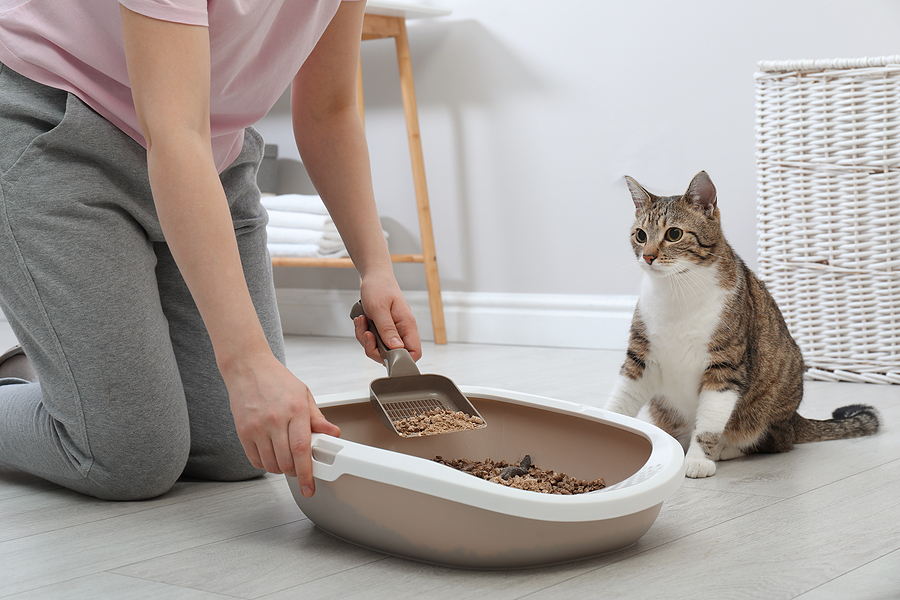Do your cats do strange things in and around their litter box? Maybe they stand on the corners of the box and won’t touch the litter with their paws. Or run through the house at top speed after they have a bowel movement. Don’t worry. These (and many other) litter box behaviors are more common than you may think.
It’s a Crap Shoot
Kelli Shoup adopted two female kittens over a year ago. “Jinks and Ellie poo together. If one sees the other start, the other cat runs up and starts, too, in a nearby litter box,” Shoup says. She says they’ve performed their “poo-off” for as long as she’s had them.
Helping Clean the Litter Box
Many cat owners talk about their cats getting inside the litter box when they begin scooping them. “Our cat, Pilot, loves a clean litter box! Well, all three of our kitties do,” says Stephanie Piro, syndicated cartoonist/illustrator. “We have two litter boxes in a little hallway next to each other. One is covered and one isn’t.
“With Pilot, he will wait on the steps but, as soon as I take the cover off and begin scooping out the litter, he will make a beeline for that one. I don’t know if it’s because this is his preferred box and he wants to make sure our other cats, Pigeon and Peaches, know their place.” Piro says Pilot is funny about his litter box. So, she usually finishes scooping the other box and, when he’s done, she scoops that box again.
“Cats will sometimes jump into the litter boxes and often use them while, and right after, their people have scooped them,” says Marilyn Krieger, certified cat behavior consultant. “Cats love clean litter boxes, ones that are freshly scooped and don’t smell of excrement. Also, there could be a sense of security and connection to their favorite people for some felines and they will use the litter box when their person is nearby.”
“I’m Not Touching That Litter!”
It’s an amusing sight if you’ve ever witnessed a cat trying to balance herself on the sides of the litter box and go to the bathroom without putting her paws in the litter. Piro says her cat, Pilot, will usually pee in the box he likes best and she usually waits until he’s done. “He normally likes the cover on. He will stick his head out and put his front paws on the edge of the doorway,” she says.
Shoup has had a similar experience, “When Jinks pees, she does it in a corner so she can have three of her four legs on the edge of the box,” she says.
“This behavior usually means either the litter boxes are too small or the locations are not ideal from the cats’ perspectives. Litter boxes should be one and a half to two times the length of the cat and they should be located in areas where cats won’t instinctively feel they might be trapped or cornered,” Krieger says.
Litter boxes need to be placed in areas with a view, yet with low traffic. Closets, cabinets, or behind doors are poor locations for litter boxes because cats can’t see potential threats, she says. “Another factor to look at is how clean the litter boxes are. Have they recently been scooped? Are the boxes dumped of litter on a frequent basis, washed, and refilled with fresh, new litter?”
Getting the Zoomies Afterward?
Many cat owners say that kitty gets the zoomies (running through the house as fast as she can) after having a bowel movement. It’s amusing to see, but also a mystery as to why a cat does this zoomie dash.
Kelli Shoup says her late cat, Kitty, would do this, “She would run for five minutes after pooing.”
“No one knows for sure, but there are some theories,” says Krieger. “Cats, like people, have a vagus nerve, which is stimulated after a bowel movement. Sometimes it causes a sense of euphoria and lightness after eliminating. The outward display of these feelings may be the zoomies.
“Another theory is that cats like clean litter boxes and that after they use the boxes, they’re not clean anymore, so they zoom away from the soiled box.
“A medical issue, such as constipation or diarrhea or pain when eliminating may also be an underlying cause for the zoomies.” Krieger says she leans toward theories number one and number three for the post-bowel movement zoomies.
Then there’s this thought: Litter box quirks could be just one of many ways for kitty to always keep you mystified.
This article was reviewed/edited by board-certified veterinary behaviorist Dr. Kenneth Martin and/or veterinary technician specialist in behavior Debbie Martin, LVT.








